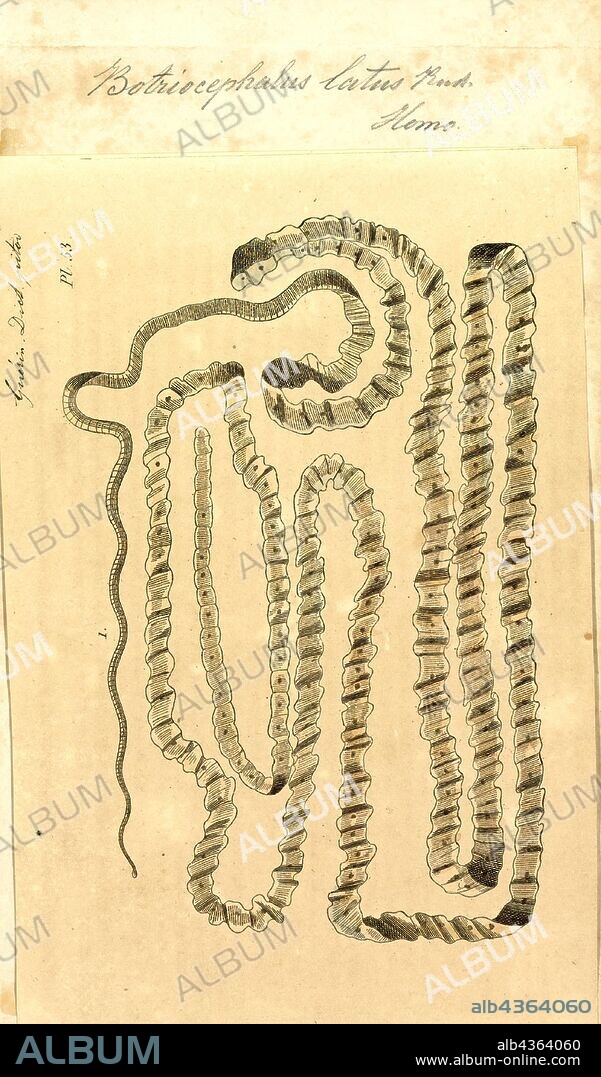alb4364060
Bothriocephalus latus, Print, Diphyllobothrium is a genus of tapeworms which can cause diphyllobothriasis in humans through consumption of raw or undercooked fish. The principal species causing diphyllobothriasis is Diphyllobothrium latum, known as the broad or fish tapeworm, or broad fish tapeworm. D. latum is a pseudophyllid cestode that infects fish and mammals. D. latum is native to Scandinavia, western Russia, and the Baltics, though it is now also present in North America, especially the Pacific Northwest. In Far East Russia, D. klebanovskii, having Pacific salmon as its second intermediate host, was identified. Other members of the genus Diphyllobothrium include Diphyllobothrium dendriticum (the salmon tapeworm), which has a much larger range (the whole northern hemisphere), D. pacificum, D. cordatum, D. ursi, D. lanceolatum, D. dalliae, and D. yonagoensis, all of which infect humans only infrequently. In Japan, the most common species in human infection is D. nihonkaiense, which was only identified as a separate species from D. latum in 1986. More recently, a molecular study found D. nihonkaiense and D. klebanovskii to be a single species.

|
Add to another lightbox |
|
Add to another lightbox |



Caption:
Bothriocephalus latus, Print, Diphyllobothrium is a genus of tapeworms which can cause diphyllobothriasis in humans through consumption of raw or undercooked fish. The principal species causing diphyllobothriasis is Diphyllobothrium latum, known as the broad or fish tapeworm, or broad fish tapeworm. D. latum is a pseudophyllid cestode that infects fish and mammals. D. latum is native to Scandinavia, western Russia, and the Baltics, though it is now also present in North America, especially the Pacific Northwest. In Far East Russia, D. klebanovskii, having Pacific salmon as its second intermediate host, was identified. Other members of the genus Diphyllobothrium include Diphyllobothrium dendriticum (the salmon tapeworm), which has a much larger range (the whole northern hemisphere), D. pacificum, D. cordatum, D. ursi, D. lanceolatum, D. dalliae, and D. yonagoensis, all of which infect humans only infrequently. In Japan, the most common species in human infection is D. nihonkaiense, which was only identified as a separate species from D. latum in 1986. More recently, a molecular study found D. nihonkaiense and D. klebanovskii to be a single species.
Credit:
Album / quintlox
Releases:
Model: No - Property: No
Rights questions?
Rights questions?
Image size:
2798 x 4766 px | 38.2 MB
Print size:
23.7 x 40.4 cm | 9.3 x 15.9 in (300 dpi)
Keywords:
1986 • BALTICS • BOTHRIOCEPHALUS LATUS • BROAD FISH TAPEWORM • BROAD • CAUSE DIPHYLLOBOTHRIASIS • COMMON SPECIES • CONSUMPTION • CORDATUM • D • DALLIAE • DIPHYLLOBOTHRIUM LATUM • DIPHYLLOBOTHRIUM • FAR EAST RUSSIA • FISH TAPEWORM • GENUS DIPHYLLOBOTHRIUM INCLUDE DIPHYLLOBOTHRIUM DENDRITICUM • GENUS • HAVING PACIFIC SALMON • HUMAN INFECTION • HUMANS • IDENTIFIED • INDÍGENA • INDIGENAS • INDIGÈNE • INDIGENOUS PEOPLE • INDIGENOUS • INFECT HUMANS • INFECTS FISH • INFREQUENTLY • JAPAN • JAPANESE • KLEBANOVSKII • LANCEOLATUM • LARGER RANGE • LATUM • MAMMALS • MEMBERS • MOLECULAR STUDY • NATIVE • NATIVES • NIHONKAIENSE • NORTH AMERICA • NORTH AMERICAN • NOW • PACIFIC NORTHWEST • PACIFICUM • PEOPLE • PRESENT • PRINCIPAL SPECIES CAUSING DIPHYLLOBOTHRIASIS • PRINT • PSEUDOPHYLLID CESTODE • RAW • RECENTLY • SALMON TAPEWORM • SCANDINAVIA • SECOND INTERMEDIATE HOST • SEPARATE SPECIES • SINGLE SPECIES • TAPEWORMS • THOUGH • UNDERCOOKED FISH • URSI • WESTERN RUSSIA • WHOLE NORTHERN HEMISPHERE • YONAGOENSIS
 Pinterest
Pinterest Twitter
Twitter Facebook
Facebook Copy link
Copy link Email
Email

